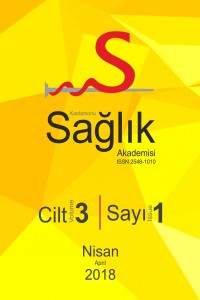Farklı kalınlıklardaki yüz protezlerinde kullanılan silikon elastomerlerin translüsensi ve sertliklerinin değerlendirilmesi
Abstract
Yüz bölgesindeki kulak, göz, burun ve çevre
dokularının defektlerinde yüz protezleri yaşam kalitesini arttıran tedavi
seçeneğidir. Yüz protezlerinin yapımında kullanılan silikon elastomerler çevresindeki
deri ile renk ve translüsensi açısından benzerlik gösterebilmeli ve dokulara
yakın sertliğe sahip olmalıdır. Bu çalışmanın amacı silikon elastomerlerin
kalınlığının, materyalin translüsensi ve sertlik özellikleri üzerindeki
etkisini değerlendirmektir.
Çalışmada, çapı 15 mm ve kalınlıkları 0,5 mm, 1 mm, 2
mm ve 5 mm olan (n=10) disk şeklinde silikon elastomer örnekler hazırlandı.
Örnekler hazırlanırken materyal yapısına ağırlık olarak % 2 oranında pigment
ilave edildi ve alçı kalıplarda polimerizasyonları yapıldı. Hazırlandıktan 24 saat sonra, her bir örneğin
yüzeyinden siyah ve beyaz arka plan üzerinde spektrofotometre ile renk ölçümü
yapıldı ve rengin CIE L*a*b* koordinatları belirlenerek translüsensi
parametresi (TP) tespit edildi. Silikon elastomer örneklerin Shore A yüzey
sertliği, sertlik ölçüm cihazı kullanılarak ölçüldü. Grupların; TP değerleri
Kruskal-Wallis testi ve sertlik değerleri Tek yönlü Varyans Analizi (ANOVA ) testi
ile karşılaştırıldı (a=0,05).
Gruplara ait TP
değerlerinin kalınlık ile birlikte azaldığı belirlendi ve Kruskal-Wallis
analizi sonucu gruplar arasında istatistik olarak anlamlı fark bulundu (P<0,05). En yüksek sertlik
değerlerinin sırasıyla 1 mm, 2 mm, 0,5 mm ve 5 mm kalınlığa sahip gruplara ait
olduğu ve gruplar arasında anlamlı farklılık görülmediği tespit edildi (P>0,05, P=0,052).
Bu çalışmanın sonucunda; silikon elastomerlerin
kalınlığının arttıkça translüsensi parametresinin azaldığı ve farklı kalınlıklarda
Shore A sertliği arasında fark olmadığı bulundu.
Keywords
References
- Referans1. Karakoca S, Aydin C, Yilmaz H, Bal BT.Retrospective study of treatment outcomes with implant-retained extraoral prostheses:survival rates and prosthetic complications. J Prosthet Dent 2010;103:118-26.
- Referans2. Toljanic JA, Eckert SE, Roumanas E, BeumerJ, Huryn JM, Zlotolow IM, et al. Osseointegratedcraniofacial implants in therehabilitation of orbital defects: an update of a retrospective experience in the UnitedStates. J Prosthet Dent 2005;94:177-82.
- Referans3. Anderson JD, Szalai JP. The Toronto outcomemeasure for craniofacial prosthetics: a condition-specific quality-of-life instrument. Int J Oral Maxillofac Implants 2003;18:531-8.
- Referans4. Bal BT, Yilmaz H, Aydin C, Karakoca S, Tokman B. Histopathologic study of rat connective tissue responses to maxillofacial silicone elastomers. J Mater Sci Mater Med. 2009 Sep;20(9):1901-7.
- Referans5. Murata H, Hong G, Hamada T, Polyzois GL. Dynamic mechanical properties of silicone maxillofacial prosthetic materials and the influence of frequency and temperature on their properties. Int J Prosthodont. 2003 Jul-Aug;16(4):369-74.
- Referans6. Kulkarni RS, Nagda SJ. Colour stability of maxillofacial silicone elastomers: a review of the literature. Eur J Prosthodont Restor Dent. 2014 Sep;22(3):108-15.
- Referans7. Henry PJ. Maxillofacial prosthetic considerations. In: Worthington P, Branemark PI, editors. Advanced osseointegration surgery: maxillofacial applications. Chicago: Quintessence, 1992, 313- 326.
- Referans8. Karakoca Nemli S, Çağlar A, Sarısoy Ş. İmplant destekli kulak protezinde doku uyumunun sağlanması: olgu sunumu. Gazi Üniv Diş Hek Fak Derg. 2010;27(3): 201-206.
- Referans9. Andres CJ, Haug SP. Facial prosthesis fabrication: coloration techniques. In Taylor TD. Clinical maxillofacial prosthetics. Chicago, IL: QuintessencePublishing Co, Inc; 2000. P.233-244.
- Referans10. Hu X1, Johnston WM. Translucency estimation for thick pigmented maxillofacial elastomer. J Dent. 2011 Jul;39 Suppl 1:e2-8.
- Referans11. Xiao K, Zardawi F, van Noort R, Yates JM. Color reproduction for advanced manufacture of soft tissue prostheses. J Dent. 2013 Nov;41 Suppl 5:e15-23.
- Referans12. Hu X, Johnston WM, Seghi RR. Measuring the color of maxillofacial prosthetic material. J Dent Res. 2010 Dec;89(12):1522-7.
- Referans13. Coward TJ, Seelaus R, Li SY. Computerized color formulation for African-Canadian people requiring facial prostheses: a pilot study. J Prosthodont. 2008 Jun;17(4):327-35.
- Referans14. Seelaus R, Coward TJ, Li S. Coloration of silicone prostheses: technology versus clinical perception. Is there a difference? Part 2, clinical evaluation of a pilot study. J Prosthodont. 2011 Jan;20(1):67-73.
- Referans15. Tsumura N, Usuba R, Takase K, Nakaguchi T, Ojima N, Komeda N, et al. Image-based control of skin translucency. Applied Optics 2008;47:6543–9.
- Referans16. Johnston WM, Ma T, Kienle BH. Translucency parameter of colorants for maxillofacial prostheses. International Journal of Prosthodontics 1995;8:79–86.ü
- Referans17. Polyzois GL, Eleni PN, Krokida MK. Optical properties of pigmented polydimethylsiloxane prosthetic elastomers: effect of "outdoor" and "indoor" accelerating aging. J Craniofac Surg. 2011 Sep;22(5):1574-8.
- Referans18. Hungerford E1, Beatty MW, Marx DB, Simetich B, Wee AG. Coverage error of commercial skin pigments as compared to human facial skin tones.J Dent. 2013 Nov;41(11):986-91.
- Referans19. Hulterström AK, Ruyter IE. Changes in appearance of silicone elastomers for maxillofacial prostheses as a result of aging. Int J Prosthodont. 1999 Nov-Dec;12(6):498-504.
- Referans20. Veres EM1, Wolfaardt JF, Becker PJ J Prosthet Dent. An evaluation of the surface characteristics of a facial prosthetic elastomer. Part III: Wettability and hardness. 1990 Apr;63(4):466-71.
Details
| Journal Section | Research Article |
|---|---|
| Authors | |
| Publication Date | April 30, 2018 |
| Submission Date | September 5, 2017 |
| Acceptance Date | November 7, 2017 |
| Published in Issue | Year 2018 Volume: 3 Issue: 1 |
Health Academy Kastamonu is included in the class of 1-b journals (journals scanned in international indexes other than SCI, SSCI, SCI-expanded, ESCI) according to UAK associate professorship criteria. HEALTH ACADEMY KASTAMONU Journal cover is registered by the Turkish Patent Institute.

